At Dynamicland, The Building Is The Computer
This computational research lab is reinventing computer programming

Walking into Dynamicland, a computational research lab and communal computer in Oakland, the first thing I notice is the array of projects spread out across several work tables and the kitchen countertop. 3D printed math sculptures, stuffed animals, kids toys disassembled for parts, and a MIDI keyboard connected to a Raspberry Pi. There’s enough art supplies to rival any Kindergarten classroom: markers and crayons, glue sticks, silly putty, felt tokens, pipe cleaners. Giant posters line the walls, with titles like “Annotation of the Celera Human Genome Assembly” and “Outline of the Discussion Leading to Maxwell’s Equations.” Bret Victor, the engineer-designer who runs the lab, loves these information-rich posters because they break us out of the tyranny of our glassy rectangular screens.
In one corner of the building, there’s a library. The books are centered around STEM but reach well into the arts and humanities. A copy of A History of Engineering & Science in the Bell System sits on the coffee table, and on one wall there is a poster labeled “Every Representation of Everything (in progress),” showcasing examples of different musical notation systems, sign languages, mathematical representations, chemistry notations.
Dynamicland is a non-profit that resides somewhere between an academic research lab and a Silicon Valley startup, between physical and digital, and between computing’s distant past and its future. The researchers here are inventing a new computational medium.
What is a computational medium — and how is one invented?
Before we get into that, let’s look at an ancient medium: The map. Map reading is a complex and uniquely human skill, not at all obvious to a young child. You float out of your body and into the sky, leaving behind the point of view you’ve been accustomed to all your life. Your imagination turns squiggly blue lines and green shading into creeks, mountains, and forests seen from above. Bringing it all together in your mind’s eye, you can picture the surroundings.
Maps are so beautifully matched to our mental faculties. We train our minds around them. They shrink vast topographies to human scale so we can dream and reason about them in ways that were previously impossible — our street, our planet, distant moons.
It feels so natural, yet maps had to be invented, and the invention of the map transformed civilization. It greatly expanded our cognitive reach, giving us the ability to depict rich geographic information.
And you don’t have to be a professional cartographer to draw a map. A kid with a crayon and a napkin can map their neighborhood, complete with secret hideouts, friends’ houses, parks, and skate spots. That’s the beauty of physical media, as opposed to digital media: You can create it with anything you can find. Draw on a napkin. Draw in the sand with a stick. The medium is open to a wide range of improvisation.
Digital media, however, tend to be more rigid. Commercial apps force us into ways of working with media that are tightly prescribed by a handful of people who design them. For example, Instagram has exactly three brush tools for drawing on photos, and five typefaces. Creative flexibility beyond that is possible but requires a lot more effort.
Of course, every medium has limits. What is at first liberating eventually becomes a prison that constrains our expression and our range of thought. Because every medium has limits, there’s always an opportunity to invent new media that will expand our ability to understand the world around us, to communicate, and to address major problems of civilization.
A lot of what we use today is extended from our analog past: email, digital books, and digital photos are more or less direct carryovers from physical letters, books, and photos. And this tendency has bled into hardware products: We’ve extended $0.05 pencils and $0.005 paper by creating $200 digital pencils and $1,000 digital tablets. By carrying forward some of the elegance of pencil and paper into the digital realm, we cheat ourselves out of discovering entirely new approaches.
That’s what Dynamicland has been looking for: New approaches. Media that can only grow out of the substrate of computing and electronics.
The invention of a new medium is an iterative chicken-and-egg dilemma; a long-term push and pull between the medium and the work created with it. For the invention of the Smalltalk programming system in the 1970s at Xerox’s Palo Alto Research Center (PARC), each 2–4 year research cycle followed the same steps:
- Build applications in the language
- Based on that experience, redesign the language
- Build a new system based on the redesign.
Over the course of a decade, researchers went through five of these cycles before issuing the first public release of Smalltalk. It became a seminal programming language, and the most popular modern languages like Python and JavaScript incorporate major ideas — like object-oriented programming and reflection — that began with Smalltalk. Smalltalk’s graphical user interface became the basis for the look and feel of the Macintosh.
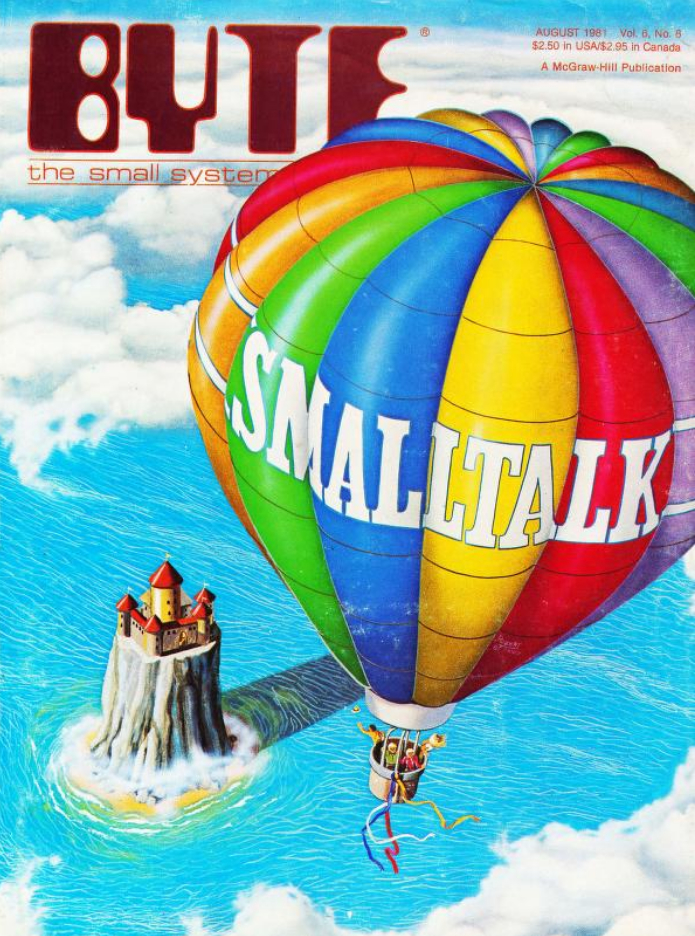

Byte Magazine Smalltalk issue, August 1981 Internet Archive
The Smalltalk research team was led by computing pioneer Alan Kay. A man of big visions and the technical expertise to back them up, Kay is a natural teacher, charming and full of great stories and anecdotes about innovation. His lifelong work is to create a dynamic computational medium — and dynamic literacy — for children. In the late 1960s, Kay crafted an early prototype of a laptop/tablet computer out of cardboard, decades before it was feasible to produce, calling it “A Personal Computer For Children Of All Ages.”
Over the decades, Kay has migrated between advanced research departments in large companies like Apple and HP, more recently via his own LA-based institute, Viewpoints Research. In his talks, he argues that the conditions for critical long-term research that can really benefit humanity rarely happen inside of corporations because of the market’s obsession with quarter-by-quarter financials. To make real progress, research needs to be protected from that.
In 2013, Kay began to partner with Vishal Sikka, the affable tech executive and Mr. Bean doppelgänger, to create a new lab to reinvent computing in the spirit of Xerox PARC. Sikka was committed to Kay’s vision, and as the CTO of SAP he had the resources to fund it. The lab was called The Communication Design Group (CDG). Kay hired three principal investigators: Dan Ingalls, Vi Hart, and Bret Victor, offering them space and time in San Francisco.
For Victor, whose design work at Apple influenced the iPad and Apple Watch, the golden era of long-term research at Xerox PARC, Bell Labs, and other institutions in the 1960s and 70s had always seemed locked in the past. It was folklore to be shared among nerds over beer. But when Kay approached Victor and the other researchers to form CDG, it was clear that there was a torch to be carried forward, with each researcher bringing their own perspective into the mix.
Inspired by Kay’s vision, Victor soon discovered that inventing new dynamic media was the work he was born to do. Over the years, Victor had come to the conclusion that people desperately need to be relieved of many of the basic assumptions about what programming is and who gets to have the privilege of doing it; assumptions that settled into the sedimentary layer of technology 40 years ago and have barely moved since.
If we want a future where everyone can program as easily as drawing a map on a napkin, where the full power of computing is available to more than just professional programmers, we may need to reimagine programming itself.
Traditionally, programming languages exist within a holy trinity: The language, the tools, and the operating system. The trinity allows programmers to become masters of a general-purpose toolset that works across many languages. As C++ creator Bjarne Stroustrup writes in The Design and Evolution of C++, “The need for a programming language to be just a cog in a much larger machine is of utmost importance to most industrial users.” He attributes C++’s broad appeal to its ability to fit into the trinity. It’s very helpful to professional programmers when languages can play well together. The desire for interoperable languages and common tools is what holds the trinity in place, and any language that tries to break out has very little chance of becoming very popular.
As a result, most professional programmers today spend their days editing text files inside an 80-column-wide command line interface first designed in the mid-1960s. And most people don’t even question it. But there is a subculture of programmers — with Victor as its natural center — who believe that programming is in a Dark Age because of this near-universal commitment to the trinity.
We need programming systems that break out of the trinity, that feel alive and fluid and that are situated closer to the domains most people care about. Spreadsheets hint at an alternative: They provide an environment that gives immediate feedback, where the code and the data live together in a graphical interface, with a language that is well-suited to common tabular data problems. Scratch, a popular programming system for children developed at MIT, is designed for play and creativity.
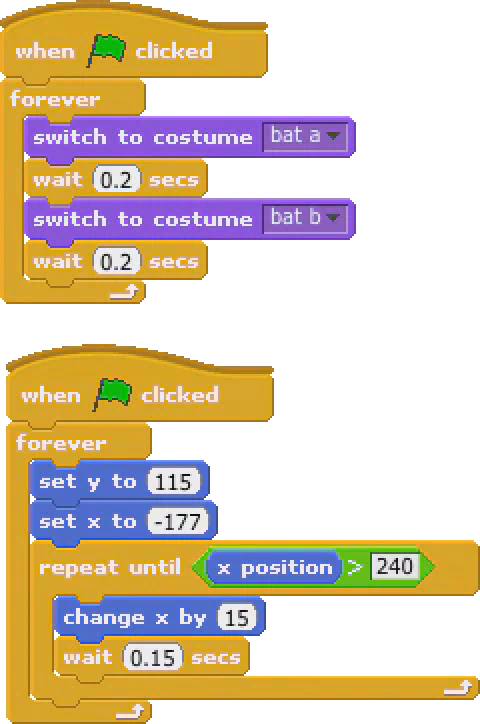
In Scratch, programs come together like jigsaw puzzles. Wikimedia
Learning programming is about learning problem solving while exploring the special kind of creativity that computers and software afford. Programming is where information becomes a living thing capable of movement, flowing through systems and adapting itself to various processes and models. It allows information to dance. And it could be so much more beautiful, playful, humane, and accessible than what the holy trinity affords.
Working with Sikka and his team at SAP, CDG spent all of 2013 putting an insulating layer between themselves and SAP so that the research could happen. Many of the decisions they made required exceptions and workarounds to SAP policies: They wanted their own office space, they wanted the researchers to retain IP rights, and so on. In a company of SAP’s size, even with the blessing of the CTO, cutting through the red tape was exhausting for Victor, who took on a lot of the work. And simultaneously, he had to figure out how to create a research lab, find and design a space, build a team, and plan the research itself.
The work paid off, and 2014 was a very fruitful year. Victor hired four researchers to work with him, and he gave them autonomy to work on their own individual projects within a broad agenda. Early projects included ShaderShop by Toby Schachman, which allows people to create low-level graphics programs visually rather than in code; and an experiment in active video by Glen Chiacchieri, using the PBS civil rights documentary “Eyes on the Prize.”
The researchers believed they had at least 5–7 years of funding. With plenty of money in the bank, the research could be exploratory and playful. There was no pressure to make anything marketable. The researchers could drop the performance of fast-paced productivity that pervades startup culture, and work at their own natural tempo. They could follow intuitive hunches that were unlikely to lead to anything. They could spend long, quiet days reading and doing uninterrupted deep work in a direction of their choosing. And, when inspiration struck, they could work all night — or weeks on end — on a new prototype.
All that space and openness triggered at least one existential crisis. For Chiacchieri, a young software engineer recruited from MIT’s Media Lab, working for Victor seemed like a dream job at first. But knowing that he could work on absolutely anything at all led him to deeply question his values. It created a lot of anxiety and eventually depression, and in his second year at the lab he spent several despairing months spinning around in circles. “With no one telling me what to work on, I had to decide for myself what was meaningful in this life. Because of how seriously I took my work, this process was very difficult for me,” he wrote in a recent essay. Ultimately, after a series of psychedelic journeys with LSD, and existential conversations with his colleagues, Chiacchieri chose to quit tech and became a psychotherapist.
The exploratory openness of the lab was hampered in the summer of 2014, just a few months after CDG’s opening party, when Sikka left SAP abruptly. Having lost their internal champion at SAP, CDG’s longer-term future was looking unclear.
Kay largely protected the researchers from this disruption. At the time, Victor’s team was creating a prototype system called Hypercard in the World, which allowed people to attach hyperlinks to physical objects.
Victor, and researcher Robert Ochshorn, turned all of the past work of the lab into a Hypercard in the World research gallery. Point to a project or paper listed on a big “index poster” using a laser pointer, and an adjacent display would show more information about the project. Another project by May-Li Khoe, called Serengeti, used animal cut-outs to make a dynamic diorama about desert animals. Visitors could point to an animal with the laser pointer to learn more about it.
Source: Dynamicland
In late summer 2014, CDG hosted a Game Jam that was a real shining moment of fast-paced collaboration and prolificacy. Friends of the lab came over and made a dozen Hypercard in the World projects. Chiacchieri made a party game called Laser Socks using laser pointers, projectors pointed at the floor, and people jumping around in socks.
Over the next year, more exploratory prototypes were built. “I would do these weird art projects,” Schachman said. He hosted a Mirror Hacking Workshop where he invited people to create sculptures using laser-cut mirrors. At the time it seemed unrelated to the research, but upon reflection he had a big insight about collaboration and the power of eye contact, and working with physical materials, and allowing people to see what others are doing. And he began to ask, why can’t computing be more like this?
Meanwhile, the relationship with the corporate overlords at SAP gradually broke down, and by early 2016 it was clear that CDG needed a new home. Around the same time, Victor made it clear to his group that they needed to come together and build a single system, rather than work primarily on individual research projects. Several researchers didn’t want to go along for the ride, and left.
By May 2016, Kay was able to charm Y Combinator’s president and A-type startup whisperer Sam Altman. They created Human Advancement Research Community (HARC) inside of YC Research and absorbed the CDG researchers there. Altman generously agreed to fund HARC out of pocket while they waited for other promised funding to come through.
That arrangement lasted a little over a year. In July 2017, just a few months after HARC moved into a beautifully renovated building in old Oakland, Altman abruptly defunded the lab.
It’s unclear why he pulled the plug. In his Y Combinator annual letter in February 2017, he said that the work coming out of Victor’s lab “remain one of the new technologies I think most about.” But a person close to Altman told me that by July his excitement had shifted from HARC to OpenAI, another YC Research project where he is now CEO. Amidst the ashes, a burned-out Kay left for London, and the research groups disbanded.
Victor’s group, however, had one thing keeping them going: Just two weeks before they learned about HARC’s demise, the group’s new programming system — Realtalk — had taken its first baby steps. Operating at about one frame per second it was more of a crawl, but it was a very exciting crawl.
The ideas behind Realtalk incorporated all of the lessons learned from past projects like Hypercard in the World. The researchers — Josh Horowitz, Luke Iannini, Toby Schachman, Paula Te, and Bret Victor, along with producer Virginia McArthur — had spent a year designing the new system and two months bringing it to life.
Inspired by the potential of their new system, Victor’s research group opted to go out on their own, take over HARC’s Oakland space, and start fundraising for themselves.
In a talk he gave last year at Harvard, Victor laid out three major design principles from the research that were incorporated into Realtalk:
- The medium should be communal and accessible. People should learn and collaborate through awareness, with no assumption of a single, isolated user sitting at a laptop with a keyboard and mouse.
- The medium should allow people to think with their bodies, because we are more than fingers and hands.
- The medium should expand people’s agency and liberate their creativity; rather than being an app with a limited set of features defined by a corporation and imposed on people.
Instead of simulating things like paper and pencils inside a computer, Realtalk grants computational value to everyday objects in the world. The building is the computer. Space is a first-class entity — a building block of computation. Digital projectors, cameras, and computers are inconspicuously attached to the ceiling rafters, creating space on tables and walls for projects and collaboration. Most of the software is printed on paper and runs on paper. But the deeper idea is that when the system recognizes any physical object, it becomes a computational object.
it becomes a computational object.
Several of the researchers had never created such a complete, low-level system before. It narrowed their focus and brought a sense of alignment to the team just in time to start fundraising.
With only a few months of cash in the bank, trade-offs were made. Instead of perfect conceptual purity and deep flexibility, the team focused on polishing up what they had for funders.
Today, Realtalk projects have taken over most of the building — each one a little constellation of paper and light. The tables and walls are lit up with radiant multicolored comets, rain and frogs and octopi, puzzles and graphs, clocks and maps. A music sequencer by Te called Beats of the World lets you design rhythmic loops with felt tokens. GeoKit by Omar Rizwan is a giant interactive wall map.
I sit at a table and point a keyboard at a page labeled “Code editor.” An editor appears.
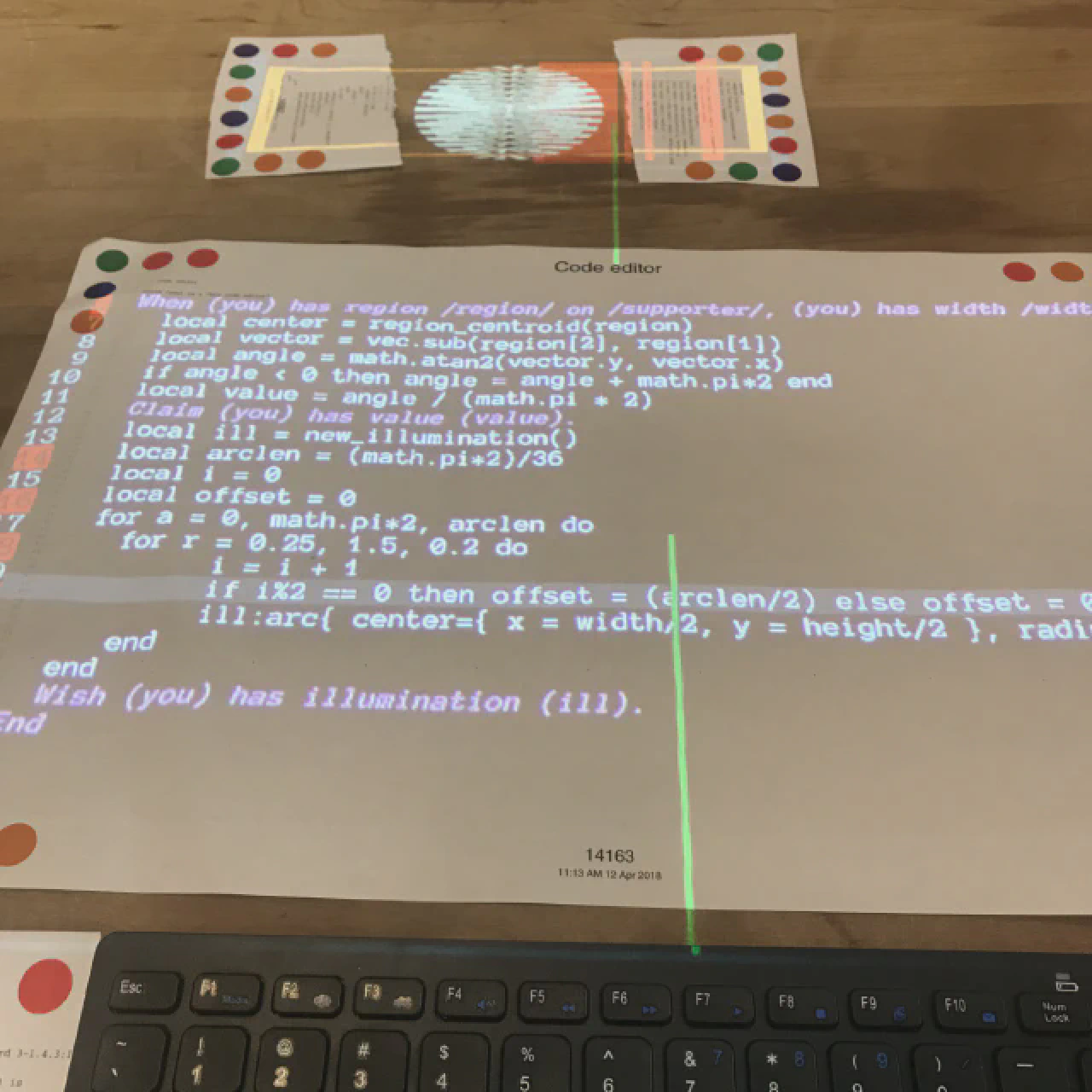
I press Control-P, and a laser printer spits out a page with my program written on it.
Here’s what the page for “Hello, World” looks like:
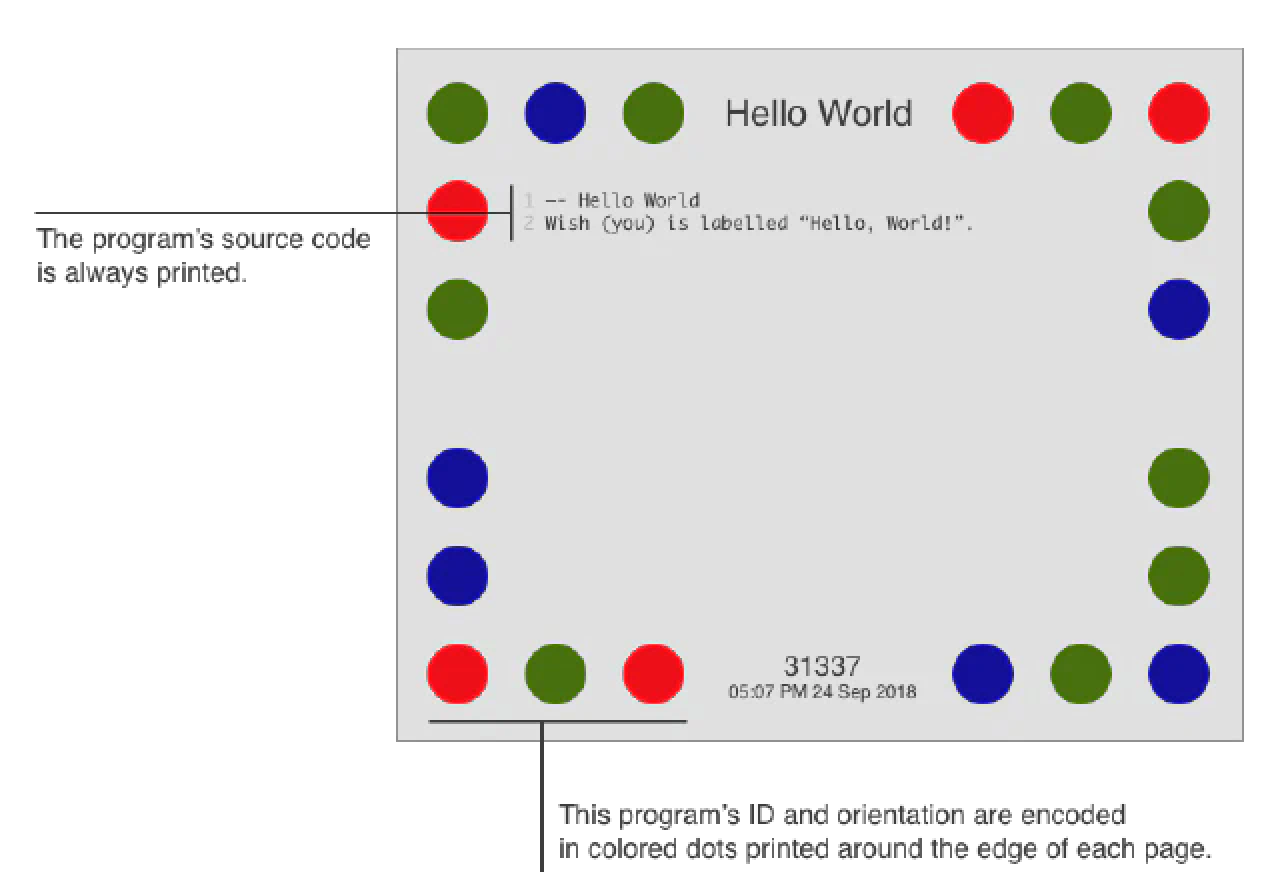
Place this page onto any surface and you will see its output projected on top:
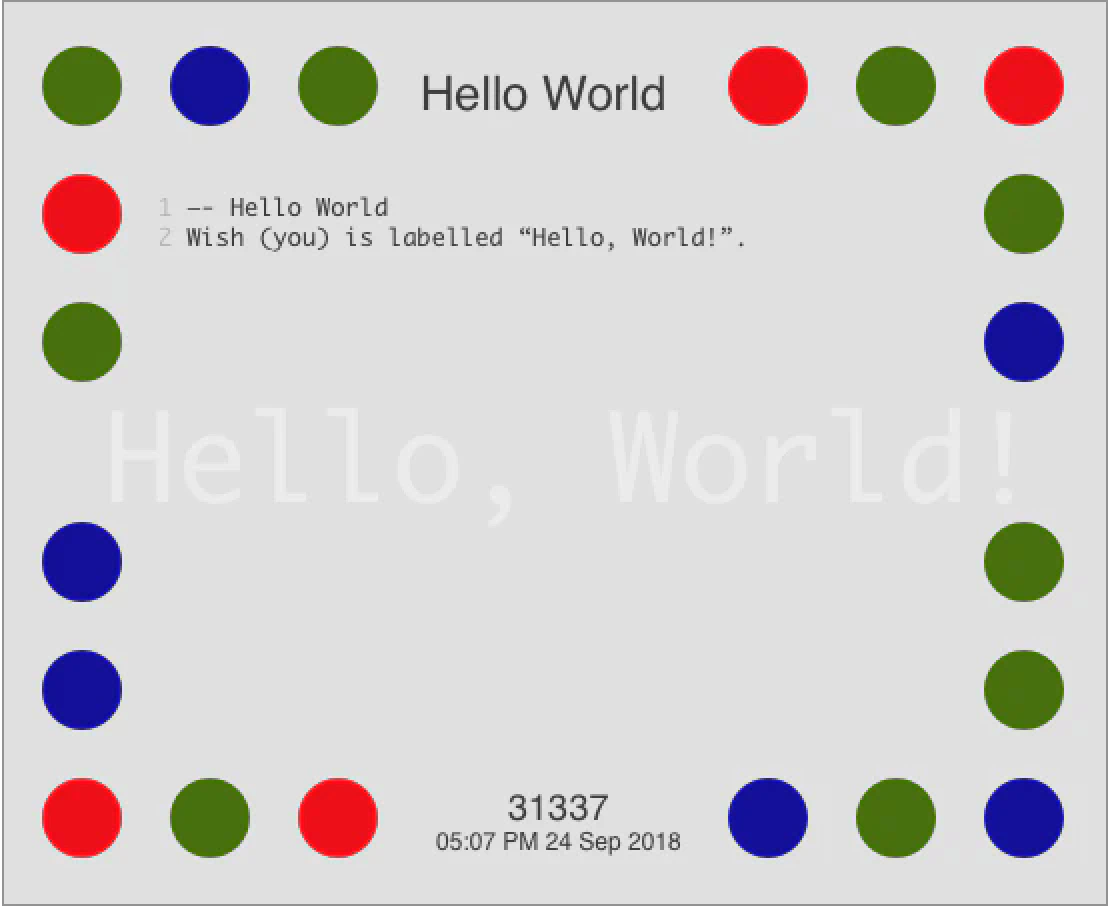
As long as it is on the table, it’s running. Flip it over and it will stop.
Paper can be cut, glittered, stamped, torn, taped, stapled and scrawled upon. It can be glued to spinners, made into miniature books, or folded into origami and flicked across the table. It’s a great format for prototyping. Kids love it. Everyone loves it. It immediately invites new ideas.
Realtalk projects come to life by writing one or more programs on pages, and physically arranging them on a table. Pages can easily communicate with each other, making composition and interactivity easy.
Aside from paper, there are also dots. The computer vision algorithm recognizes M&Ms, little felt tokens, even painted fingernails as dots. Want a slider control? Draw a straight line with a marker, place a dot onto the page, and slide it with your finger. Or glue a dot onto the end of a popsicle stick.
The entire source code for Realtalk is printed and posted across several rolling whiteboards. Developer tools for printing and debugging hang from a pegboard that would look at home in a woodshop. Projects are stuffed into binders and plastic cases labelled Dinner Party Games, Rainbow Canvas, Shape Cycle, and Radial Animation. People learn by example, reading the pages that are posted around the space, and flipping through little ring-bound tutorial zines that can be run on any surface.
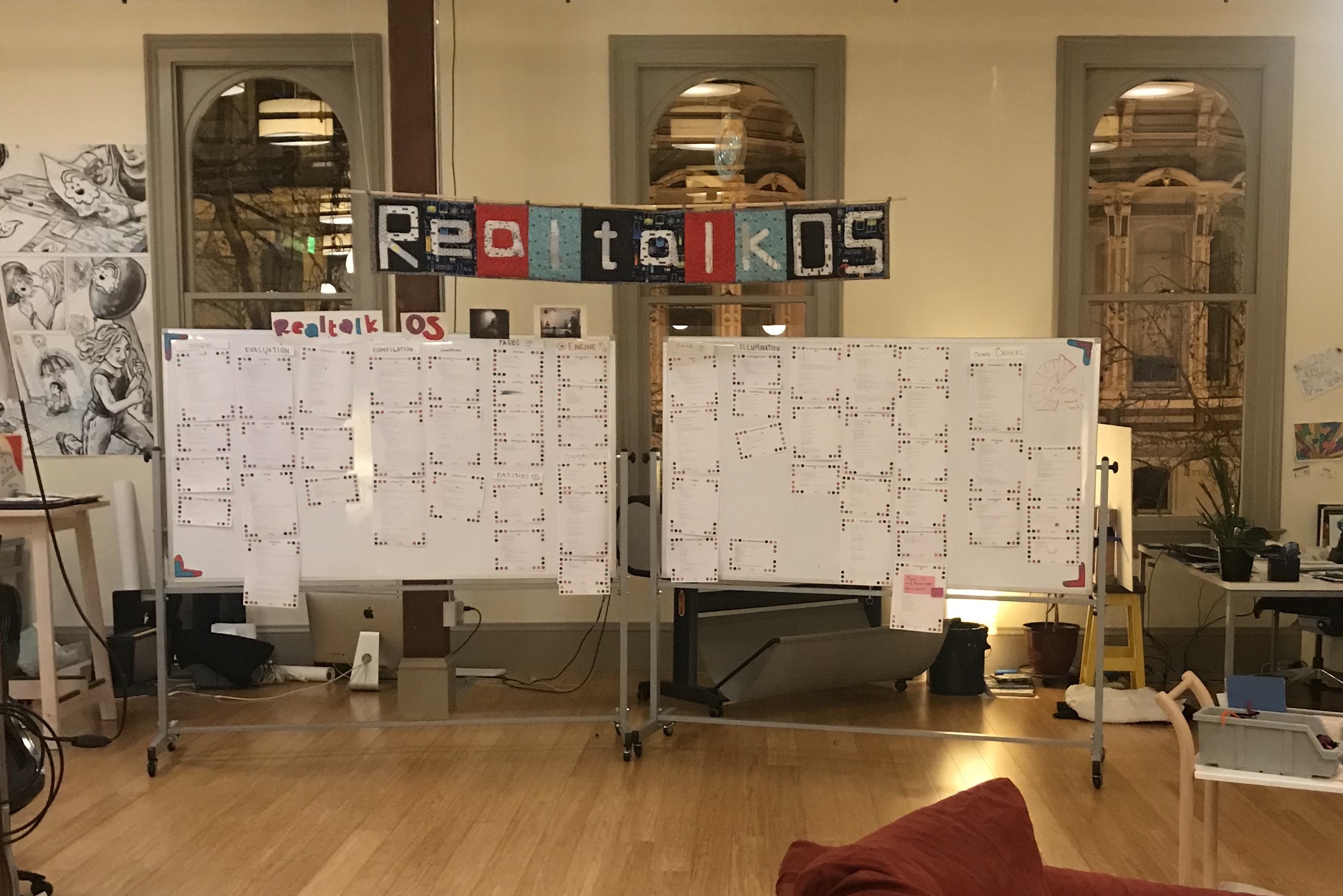

The source code for Realtalk is printed on rolling whiteboards at Dynamicland
When you place a page on the table, the code on it is continually running. When you make changes, the feedback is immediate. There’s a feeling of dancing with code that’s hard to describe. It’s easy to find the satisfaction of quick progress. It maximizes the flow of ideas. I’m constantly surprised by the new ideas that emerge from bugs and quirks. I let go of “How should it work?” as I feel my way toward what I want, allowing for happy accidents along the way.
Realtalk programs are constantly remixed and passed around. They become physical memes and are reprinted and copied and modified. I had this happen with a simple Magic 8 Ball page attached to a spinner. I wrote it without much thought, left it out on a table, and when I came back a couple weeks later I found several remixes of it around the space. Pages with emotional power or universal utility seem to proliferate.
The “communal and accessible” principle is where the lab still has a lot of work to do. It’s a hard problem. Most of the major projects on display were made by individual researchers, not a group. Several of the researchers are programmers who grew up coding by themselves, and it’s a tough habit to break. Solo flow is very seductive.
It makes sense that they’re selective about who they invite to the lab and when (and how) to share the research itself. They are sensitive to their language and working style being polluted by Silicon Valleyspeak and brogrammer culture. And there’s a tension between containing the research so it can develop in the safety of the lab environment, and creating a community space so that the medium can be designed in conversation with many kinds of people. “We have to open the research to letting more people come in and help us shape it, so that it’s not just benefitting the same kind of people who have had the privilege to become programmers,” Te said. “As someone whose perspective as a non-white non-male has always been underrepresented, my goal is to empower those who aren’t represented by dominant culture be a part of inventing new mediums.”
One element that encourages community: Dynamicland is the only place you can go to work on Realtalk projects. I can’t work on projects alone at home. There’s no GitHub for Realtalk. My time at Dynamicland feels precious, and that preciousness seems to elevate my creativity. Maybe this is what it felt like to have to schedule a block of time at a university computer before the PC era.
Is Realtalk the future? No. In the larger arc of the research, it’s just a single iteration. It’s a suggestion: Maybe by going back to the drawing board, and redesigning things further down the stack, we can escape the Dark Age of the command line, and computational literacy itself can become more accessible and communal.
Victor’s dream is to be able to experience an entire scientific paper — or the entire global supply chain — in a computationally-driven room. To explore the data with more richness and depth than would be possible on a single screen. And on the most existential level, his hope is that the research might help to avert human extinction. If we can understand the complexity of our world more broadly, we’ll be in a better long-term position to mitigate risks that may threaten civilization.
It’s early 2019 and I’m walking to meet Bret Victor at his apartment in Cambridge, Massachusetts, on the coldest day of the year. I walk past IDEO’s Cambridge office, situated right between Harvard and MIT. Design firms like IDEO sell a flavor of research that promises to deliver fresh ideas to blue chip clients. The exterior is painted with geometric shapes and bright colors that signal an appropriate amount of creativity. It says, we’re playful but serious. We’ll help you feel safe moving into some new creative territory. We’ll bring the best of Design Thinking and rapid prototyping. And we promise not to be too wild.
Dynamicland, in contrast, seems to cherish total intellectual freedom. When I first visited the lab at an open house in early 2018, I thought of Children’s Television Workshop in its heyday: Countercultural, research-backed, subversive, experimental, sometimes brilliant, always underfunded. A few tireless inventors pour themselves into the work, day and night. Open a random drawer, and it would be no surprise to find a collection of toy eyeballs rolling around inside.
Victor left the Bay Area last fall and is taking a sabbatical to recover from the intensity of years of fundraising and management of the lab. He greets me at his front door with a warm smile. Though he grew up in the Bay Area, Victor seems at home right here, steps from MIT’s campus.
He chugs away at a bottle of water while we talk. He has an encyclopedic knowledge of computer history and he loves to tell those stories. He told me about the hacker culture that emerged around the TX-0 computer at MIT in the mid-1950s. The TX-0 was down the hall from the Model Railroad Club, and some of the railroad nerds discovered that they could have the computer to themselves late at night, when researchers frequently overslept and missed their timeslots. The first known word processor was created there — it was dubbed “Expensive Typewriter” because everyone thought it was absurd to use a $3 million computer to write a term paper.
As a lifelong software engineer listening to Victor’s stories, I felt a tinge of embarrassment, having never studied the history of computer science very deeply.
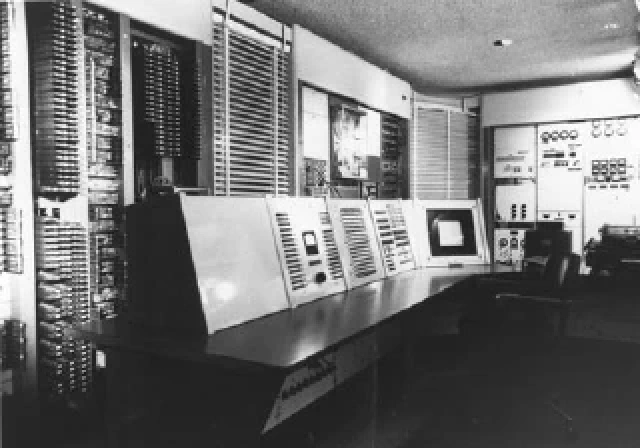
MIT’s TX-0 Computer, 1955
Computer History Museum
We end up talking for several hours. As he starts telling me the story of the lab, I get the sense he has been looking for a sympathetic ear. Some catharsis after a six-year rollercoaster ride.
He seems tired. CDG was his first management role. For a prolific maker, that’s a big shift that requires a lot of energy and personal growth. He has to own the context for context-making (Dynamicland) and contribute to the context itself (Realtalk), all while dreaming about — but having almost no time left over to make — projects within the context.
This is clearly his life’s work. He often flashes a sly grin as he tells stories about Dynamicland, looking like a little boy who knows he’s gotten away with something very clever. We talk a lot about the context-building work he did, and he says he has tried to treat Dynamicland like a biological containment facility. He’s concerned that there’s been so much damage done by half-baked ideas stolen from research labs by entrepreneurs. “The thing about taking a deep idea and making a mass-produced, superficial treatment of it, is that after that point it becomes impossible to see the deep idea,” he says.
He told me the story of Steve Jobs lifting the idea for the graphical user interface from the Smalltalk team for use in the Macintosh. In Smalltalk, the GUI was used for programming the computer. The original concept of object-oriented programming was entirely graphical — objects on the screen represented objects in the program. That was the deep idea. But in the Macintosh, the GUI didn’t allow for programming the computer at all. Jobs made a shallow clone of Smalltalk’s deep ideas in order to get the first Macintosh onto the market.
Victor’s commitment to treasuring deep ideas is his greatest strength and greatest weakness. It gives him the purpose and energy to create the context for Dynamicland, and to commit to his own deep ideas for long enough to bring them to life in beautiful ways. The risk, however, is that nothing is ever considered done and therefore nothing is ever shared. Or that every share is provisional. He seems to want to be understood so deeply that no expression of his ideas is ever quite deep enough.
Usually, one person doesn’t play both inventor and virtuoso. Les Paul invented the electric guitar to bring more warmth to his smooth jazz, and he could never have foreseen how Jimi Hendrix would use it. “The overload of the guitar comes to connote the idea of breaking the frame of the equipment — doing something that can’t be contained — and this adds a whole new side to one’s expressive palette, because one can now juxtapose things that can be contained against things that ‘can’t’,” wrote Brian Eno in his 1996 diary, A Year With Swollen Appendices.
Victor is Jimi Hendrix playing the role of Les Paul, and there’s a tension here that makes him well suited to endure cycles of making and breaking the medium as it evolves.
He doesn’t mitigate the never-ending nature of the work by looking to the horizon for market potential, as a startup founder would. The pressure on a non-profit research lab is different: They need to showcase the research in a way that invites collaboration and funding. But Victor and his team have been burned out on fundraising, which requires an incredible amount of time and energy. Also, he has his own sense of when a research cycle is done, and he doesn’t want funding to dictate that.
It may be what he needs, however. The funding rollercoaster has been an instrumental driver at Dynamicland. The lab has benefitted from external accountability to reign in the very personal creative research work, and Dynamicland has a strong record of creative output since 2013, even though Victor doesn’t seem to relish being the limelight for a big demo or presentation. The work shows itself off in the tech community. Dynamicland is social media candy, and visitors can’t help posting about how amazing Realtalk is, so the project has a life of its own on the internet.
But how will the research reach a larger audience? Can the impact of it be designed or even steered, or is it completely out of their hands?
“I don’t know what the solution to reaching a large audience is,” he says. “Maybe it takes a hundred years. It was a hundred years from the invention of the printing press to books being part of the general culture.”
Later, he told me they have plans. In July 2019, Dynamicland started working on Realtalk-2020 — the next iteration of their programming system.
In the purview of a venture capitalist, technological innovation happens through the evolutionary process of the entire startup ecosystem. Through many cycles of birth and death and acquisition. But, if every startup operates under exactly the same set of constraints of runway and product-market fit and single-origin espresso, it puts a damper on exactly the kind of deliberate creativity that Dynamicland fosters. We need more organizations like Dynamicland, occupying the space between startups and academic research labs. Places designed to dream in longer timelines.
Back home in San Francisco, I can’t help but wonder about the inner motivations that the researchers bring to the work. If the research is very open-ended, then perhaps a researcher’s work is only “done” once they resolve a core dilemma within themselves. Chiacchieri wants to help people feel happier, and this discovery has led him to psychotherapy training. Schachman cares so much about eye contact and playful collaboration in Realtalk, because he wants to feel more connected. Te hopes to create a medium that truly honors diversity, because she wants to feel a greater sense of belonging in the world of computational research.
And Victor?
Through the millennia, empirical evidence and bottom-up scientific discovery has gradually claimed territory from traditional top-down religious doctrine. What we consider unknown or mysterious continues to shrink, even if the scale of the cosmos means that the shrinkage takes the form of ∞ - x, where ∞ is the vast unknown and x is all of human knowledge.
From the outside, Victor seems most excited about expanding x, following in the footsteps of the great scientists and researchers. But what are his inner motivations?
A desire to expand awareness. To be more “in the world.” To experience the full complexity of reality just as it is. To explore the creative potential of empty space. To be free of the conditioned thinking of peers. To break out of prisons of representation.
Coincidentally, these are major themes of the Indian spiritual philosopher J. Krishnamurti’s discourses on spiritual enlightenment in the mid-20th century.
Krishnamurti had the difficult job of speaking for the ∞ side of the divide. He had a hyper-rational perspective on spirituality, he distrusted religion and ideology, and he promoted rigorous empirical self-inquiry. While Victor explores representation, simulation, and modeling of the external world, Krishnamurti asks that we methodically, internally let go of all representations and concepts.
“[Is the mind] capable of being free, empty?”, writes Krisnamurti. “It can be empty only by understanding all its projections and activities, not off and on, but from day to day, from moment to moment. Then you will find … that the state of creative emptiness is not a thing to be cultivated — it is there, it comes darkly, without any invitation, and only in that state is there a possibility of renewal, newness and revolution.”
Victor wants to experience the revolutionary ∞. He seems to be on a spiritual quest, seeking an insight that Alan Kay calls “a kerpow.” An opening into a new dimension. Because deeper than any deep idea, somewhere beyond the land of ideas entirely, there is a rich and boundless terrain that has never been mapped, though we have tried for thousands of years.
Thanks to Siobhán Cronin, Matt Hackett, and Xiaowei Wang for your feedback and support.